#elevation oblique
Explore tagged Tumblr posts
Text
youtube
This video showcases my Blender model of the planet that the Scud aliens call home, the fourth and final world I've mapped out for @jayrockin's "Runaway to the Stars" project. A *lot* of maps were created in service of this final render, and also in service of presenting the special qualities of this planet. I intend to show you as many of these as I can under the cut, and also in subsequent posts focusing on some of the more interstitial, ancillary maps and figures that played a part in producing the primary maps you'll see in this main post.
Before I show the first maps I made for this project, what you see below are the satellite-style maps for the Equinoxes and Solstices, in order of (Northern) Spring, Summer, Fall, and Winter, the latter serving as the texture for the Blender object you saw in the video.




__________
With that matter covered, our next focus is this project's foundation: Geology. While I didn't spin as elaborate a tectonic history for this planet as I did for the Ayrum commission, I did work out as much detail as I could for the more recent geological activity, to set the stage for the elevation data - including a narrower focus on the coastal shallows that host the Scud populations.




__________
Once I could move on to climate, my first step was finding this planet's relative Insolation, which I managed thanks to @reversedumbrella's code and coaching. With an obliquity of only 16 degrees, this planet's yearly maximum Insolation levels stick close to the equator, compared to pole-to-pole oscillation we see on Earth

__________
Having a rough sense of where heat would concentrate seasonally and how the landmasses would deflect water in light of the planet's retrograde spin, I was able to set down the bi-annual ocean currents (Northern Summer above and Northern Winter below), then the monthly water temperatures pushed around by said currents, and finally -after factoring in many other considerations- the monthly land temperatures as well (combined in the second gif)


__________
Next came the seasonal air pressure maps and subsequent wind patterns (my first time creating those from scratch), which later factored into the precipitation maps. The incredible temperatures at the largest continent's interior make a desert of most of it, and the other interiors are fairly dry too, but all that heat on the equatorial ocean generates a *lot* of evaporation which ends up coming down elsewhere.




__________
With temperatures and precipitation mapped out for each month, I was able to find how the accumulation and melt of ice and snow played out, too. Given such a hot equator it's surprising to see freezing temperatures hold out in some places, but low obliquity and high elevation shield what areas they can, it seems.


__________
All this monthly data was then painstakingly combined and compared and plugged into equations to produce maps of discrete climate zones, using both the Köppen (left) and Trewartha (right) classification systems. The higher latitudes see some overlap with Earth's conditions, but the Tropics...


__________
I never really finished the map I wanted to make with my own loosely customized classification system, but I *did* get as far as this breakdown of the areas that sometimes surpass 56.7 degrees Celsius, Earth's record for highest surface temperature ever directly measured. And as you can see, that earthly record is broken by a *significant* fraction of this planet's surface, and far exceeded by the equatorial continent's deep interior

__________
The final phase of this project dealt with creating satellite maps of this planet's surface (which you saw at the top of this post), which started with a map of dry and submerged substrate, then a density map of the vegetation that sits atop it, then the colors of that vegetation under annual average conditions (demonstrating how they would appear in-person, rather than the area's appearance from orbit), and finally plant colors under seasonal conditions (same conceit as previous). In concert with the seasonal ice and snow maps, it was the four maps in the last sequence which were overlaid on the Substrate map, using the plant density map as raster masks, to produce the final Satellite-Style maps.
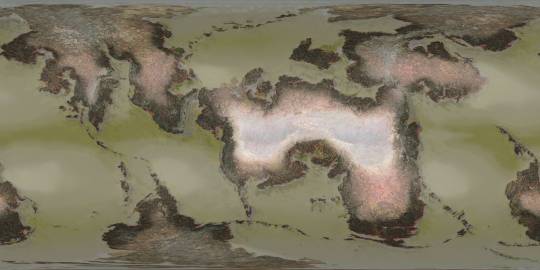



__________
This planet's sophonts being a marine species, it was then worth focusing on the conditions underwater, which included monthly seafloor temperatures (first gif), annual discharge of sediment from rivers (magenta in the 2nd gif), and seasonal upwelling of nutrients from deeper water (blue in the 2nd gif).


The creation of all my maps seen in this post was possible thanks to Photopea, which has been my go-to for several years now. The resolution kinda got crunched when I uploaded these here, so when I share them on Reddit later I'll add those links under this. These have also already been posted on Twitter, which you can see here if you like. Thanks for scrolling all the way down here!
#digital painting#Photopea#digital 3d#Blender#mapmaking#imaginary maps#Runaway to the Stars#Rtts Scuds#speculative planetology#speculative geology#speculative climatology#alien planet#major post#commission#christopher maida artwork#Youtube
731 notes
·
View notes
Text

Voronya Cave, the closest point to the center of the Earth !
Voronya Cave, also known as Krubera Cave, is the deepest cave in the world.
The cave, Krubera-Voronya, is considered the “Everest of Caves”. The total length of the cave passages reaches 13,232 m, the depth is -2,197 m. It is located in Abkhazia (Georgia) near the Sea black.
The elevation difference between the cave entrance and its deepest explored point is 2,197 ± 20 meters (7,208 ± 66 feet). It became the deepest known cave in the world in 2001, when the expedition of the Ukrainian Speleological Association reached a depth of 1,710 m (5,610 feet), which surpassed the depth of the previously known deepest cave, Lamprechtsofen, in the Austrian Alps, by 80 meters (260 feet).
In 2004, for the first time in the history of speleology, the expedition of the Ukrainian Speleological Association reached a depth of over 2,000 meters (6,600 feet) and explored the cave up to -2,080 m (-6,824 feet).
The Ortobalagan Valley extends along the Berchil'sky anticliminal ridge, which descends gently northwestward. The entrances to the caves are lined along the anticlinial ridge, but the caves are controlled by longitudinal, transversal and oblique faults and include complex winding patterns in the plant view, remaining largely within and near the ridge area anti-clinical.
Caves are predominantly a combination of shallow wells and steep snake passages, although in some places they cut seemingly ancient fossil passages at different levels.
#art#stairwell#stairway#caves#nature#earth#underworld#voronya cave#voronya#krubera cave#georgia#earth wonders#speleology
310 notes
·
View notes
Text
Gun Park x Reader: this is our place (we make the rules)
Chapter 4 - Probably should read ch1 first
Gun has a new neighbour. Index: Chapter 1 | Chapter 2 | Chapter 3 | Chapter 4 | Chapter 5 | Chapter 6 | Chapter 7 | Chapter 8 | Chapter 9 | Chapter 10 | Epilogue

You pray to the heavens above.
You pray to hell below.
And everything in between. Because something needs to have mercy on your soul.
This sight. It cannot be real.
Your eyes are deceiving you.
.
.
Of course you considered eating Gun’s food. It’s the least of what he deserves. But you didn’t have the heart to cause trouble for the careless delivery person.
Besides, what asshole steals someone else’s food?
Now this is what you get? Is it supposed to be a reward or torture?
.
.
“Why is it always you?” Gun, face impassive, stands at the doorway with towel in both hands, scrubbing at his wet hair. Damp tendrils curling at his forehead and neck.
(What you wouldn't give to be the towel in those big, strong hands.)
Expecting just a quick visit, where he could grab his lunch and needing to exchange a grunt at most, he’s wearing very little.
To you, he is wearing far too much.
Steam rises from his shoulders. His bare naked shoulders. Broad. Powerful. With that particular delicious cut of muscle linking to his underarm.
Then all arms and bis and tris in the air, graceful and frankly. Obscene. Like a ridiculous cologne advert dreamt up by horny execs.
(Praise the gods for the horny execs and the creation of this before you, a tiny voice in your brain offers.)
Your eyes continue taking in the rest of his body. Scars that should be a screaming red flag litter his torso, a fitting match for the one between his eyes, but it just elevates this man. Adding to the mystery, the danger.
Droplets from Gun’s shower slides down over his skin, now starting to prickle in the cold air. It glides down in a delectable path that your eyes are all too eager to follow.
The linen shirt from the other week seems puritanical. Far far too much material.
Because if you looked like this, why on earth would you ever wear anything ever again.
Why would you ever cover those pecs, and that 6 (hold on a second - you count each muscle), 8 pack and those obliques.
All leading to jutting hipbones, a delicious faint trail of hair starting at the navel, and that tantalising line of muscles shaped in a V. Everything pointing straight down below. Teasing at what the towel around his waist covers.
(You change your mind. What you wouldn't give to be this towel instead.)
Completely mesmerised, your hand is half reaching out before his voice slaps you out of your daze.
“Are you done?”
And like the shameless moron you are, all you can do is nod, mute, as you retract your hand. Swiping at your nose and mouth to check for a nosebleed or any drool.
Thankfully, it comes back dry.
Leaning a forearm on the door, and other hand on his hip; Gun bends at the waist, bringing his face close to yours. Much closer than it’s ever been.
“Tell me,” A smirk, “Why are you on my doorstep again.”
You gulp, and his eyes drops to watch your throat swallow.
How is it so hot in here. How is your hand clammy. And how. Really. How does he smell so good. Like whatever expensive body wash he has used and an intoxicating mix of smoke and spice.
This is a reward. Definitely.
Then your eyes dart to his lips, moist and pulled up at one corner. Too far to reach, but close enough that you can feel the heat of his breath.
No. This is torture.
“Are you,” Gun inches closer and you can’t help leaning in too, “hungry for food,” somewhere far away, you hear a faint rumble. It could be your stomach or an earthquake, you would never know, “or for something else?”
After his last words, Gun reclines, giving you the space to breathe again.
Like the first rush of cool air after drinking in a stuffy bar and it fully hits you how drunk you are.
Another rumble and you realise it’s your stomach.
The smirk never shifts, instead Gun grabs the bag from your hand and retreats back into his home.
Leaving the door wide open.
Your body, as if pulled along by a wire, follows.
.
.
Gun, infuriatingly smug that you have walked of your own accord into a lion’s den, spreads out the food and hands you a pair of chopsticks.
No. No. You are not disappointed. Definitely not.
“Eat,” he commands and disappears.
Your other brain cells start whirring. Better late than never. You blink, dazed. Sobering. As if you have no idea how you got here. How it all led here.
.
.
An unexpected turn, though not unwelcome.
Gun pulls on some fresh clothes, thinking about his next move.
He’s done a basic check on you. Common sense, standard, to check there are no nefarious purposes for you living next door.
Turns out it was just a coincidence you turning up at the same places as him.
What’s more, the PI, one who he has entrusted with many cases to, returned very little.
Barely any living relatives, no training, no big accomplishments, no connection.
A student at Seoul National University, gaining entrance through merit rather than nepotism. Some part-time job to support yourself, which you parted with on good terms once you moved. You weren’t lying when you mentioned your grandmother passing her home on to you.
Someone that shouldn’t even be on Gun Park’s radar. That doesn’t warrant any searches conducted on them.
So the interesting part, the reason you have his attention is this:
How come a nobody like you, someone whose entire existence has barely filled a side of paper, look him in the eye unflinching?
To find the abyss staring, and to just stare back.
To have so little fear of a demon, who has ruined lives of much more powerful men and women.
Gun can count on no hands and no fingers the amount of people he has invited back that he does not intend to bed.
But here you are. In his home.
He’s curious to find out more about you.
#lookism#lookism webtoon#lookism x reader#lookism manhwa#lookism fanfic#lookism fics#gun park#park jonggun#gun park x reader#park jonggun x reader#wannaeatramyeon#hello yes this is fanservice#no smut
172 notes
·
View notes
Text

The fact that Louis Tomlinson performed two covers of One Direction songs at his May 26 show at the Mohegan Sun Arena should not be a surprise.
After all, he was a member of the best-selling boy band and one of its chief songwriters.
The fact that he performed a cover by Arctic Monkeys, however, would be a surprise if you had not updated your vision of Tomlinson since his pop days with 1D.
The rocking performance at the Uncasville arena, thanks to Tomlinson’s honesty and sincerity as he attacked his material, clearly indicated that his preferred sound of the moment is the Brit Pop pioneered by Arctic Monkeys– and not the boy band groove of One Direction.
While his former bandmate Harry Styles has gone all metrosexual sophisticated as he mines his own 21st century brand of smart pop, Tomlinson favors guitar solos and intensity in his post-1D universe.
The Brit has not gone completely Led Zeppelin on us, full of blues and devoid of hooks. There were plenty of catchy melodic turns of phrase that captured the ear beneath the power chords and helped grab hold of the hearts and ears of a primarily female audience that likely had not reached their junior year of high school yet.
The rocking sound was not about career opportunities or slumming. It was clear this is where Tomlinson’s heart and soul belonged.
That said, Tomlinson’s chosen genre also has been a good career choice.
By all rights, since One Direction was launched in 2010 (when Tomlinson was still in his teens), most of the 16-year-olds who swooned over him in the second decade of the 21st century would be at the cusp of their 30s at a concert in 2023. But most of Tomlinson’s fans at the Mohegan were on the younger side of the teens with only a scattering of old school 1D fans in the mix.
Tomlinson’s musical mood swing has revitalized his continuing commercial prospects. His current album, the mighty fine “Faith in the Future” debuted at number 5 on the Billboard charts.
All the more amazing at the Friday night show is that the young crowd at the Mohegan seemed to know every word from each song on Tomlinson’s setlist. At times, they even drowned out the artist.
Tomlinson clearly has snagged the hearts and souls of a new generation of fans.
When I first listened to “Faith in the Future” last year, I was hearing hints of old school emo. But in concert, the Arctic Monkeys’ references were clear. However, even more clear for me was Tomlinson’s fondness for Oasis. That 1990s-era band was prone to Beatle-esque flourishes with grand arrangements that caused the heart to swell and fists to elevate as they were pumped in the air. And many of the songs performed by Tomlinson in Uncasville on this Friday night had those sweeping moments that carried you along to emotional crescendos.
Tomlinson’s rock and roll inclinations carried over to the stage show itself.
The first night of the tour found Tomlinson surrounded by edgy lighting with oblique and abstract video projections. There were a couple of times where the lighting reminded me of something that a band like goth-godparents Bauhaus or Sisters of Mercy would implement. It also reminded me of latter-day David Bowie shows.
Rather than guiding the emotions with videos that tell a story (which many artists will do), Tomlinson’s stage set a mood for the songs and left the internal storytelling of the songs to the fans themselves.
The stage and lighting were the antithesis of what Tomlinson might have found himself in his One Direction days.
One Direction, for most musicians, would be a hard act to follow. But Tomlinson’s Mohegan show demonstrates there is quite a vibrant rock and roll life after Simon Cowell (One Direction’s one-time career commandant) for this singer.
Tomlinson set the stage for a night of rock with his selection of opening acts. Snarls offered up a hard-hitting punkish set with a heavy musical punch. The four-man crew The Academic gave the crowd a melodic new wave-twinged set that would easily have found favor in the colorful days of the 1980s.
PHOTOS 1, 2, 3
111 notes
·
View notes
Text

How to make body fit without gym
There are many ways to get fit without going to the gym. Here are some useful tips :
Walking is a simple and effective way to improve your cardiovascular fitness, bone strength, and body fat reduction. You can walk for 30 minutes a day, or try interval walking for more intensity.
Taking stairs instead of elevators can help you burn more calories and strengthen your legs. You can start with a few floors and gradually increase the number of stairs you climb.
Bodyweight exercises such as planks, push-ups, squats, jumping jacks, and lunges can build your muscle tone, flexibility, and balance. You can do them at home with no equipment, or use household items like water bottles or furniture as weights or props.
Shadow boxing is a fun way to improve your upper body strength, coordination, and balance. You can punch at the air in front of you, or follow a video online for guidance. Don’t forget to move your feet and add some defensive moves as well.
Yoga can increase your flexibility, muscle tone, and mental well-being. You can practice yoga at home with a mat or a soft floor. There are many poses for beginners, such as tree pose or triangle pose. You can also follow a video online for instruction and inspiration.
Barre exercises are inspired by ballet and can tone your legs, core, and arms. You can use a wall, a bar, or a piece of furniture to hold on to. Some of the exercises you can try are knee lifts, ballet squats, and deep lunges.
If you want to focus on some specific areas of your body, you can try some of these exercises:
Glute bridge can help you tone your glutes, hamstrings, and lower back. To do this exercise, lie on your back with your knees bent and your feet flat on the floor. Lift your hips off the floor and squeeze your glutes at the top. Hold for a few seconds and then lower your hips. Repeat for 10 to 15 times.
Tricep dips can help you strengthen your triceps, shoulders, and chest. To do this exercise, sit on the edge of a chair or a bench with your hands on the edge and your legs extended in front of you. Slide your hips off the edge and bend your elbows to lower your body until your arms are at a 90-degree angle. Push yourself back up and repeat for 10 to 15 times.
Side plank can help you work on your obliques, core, and hips. To do this exercise, lie on your side with your elbow under your shoulder and your legs stacked. Lift your hips off the floor and keep your body in a straight line. Hold for 30 seconds and then switch sides.
Lateral raises can help you sculpt your shoulders, arms, and upper back. To do this exercise, stand with your feet shoulder-width apart and hold a pair of water bottles or books in each hand. Raise your arms to the sides until they are parallel to the floor. Lower them slowly and repeat for 10 to 15 times.
These are just some of the ways you can get fit without a gym. You can also try cycling, swimming, skipping rope, or any other activity that you enjoy and that makes you sweat. The most important thing is to be consistent and have fun! 😊
#health & fitness#health#fitness#wellness#healthcare#health is wealth#healthy living#health tips#health and wellness#healthy lifestyle#tumblr milestone#health & beauty#health & wellness
59 notes
·
View notes
Text
When NASA released images of Pluto in 2015 taken by the New Horizons spacecraft, many were captivated by the dwarf planet’s heart-shaped feature, now called Tombaugh Regio. And now the mystery of how this “heart,” which is nearly 1,000 miles (1,600 kilometers) across, came to be may be solved. A recent study in Nature Astronomy reveals how the western half of the heart, known as Sputnik Planitia, is the result of a massive impact. Based on simulations, the team suggests a planetary body roughly the size of Arizona from north to south collided with Pluto at a slow speed, creating the tear-shaped area.
“The formation of Sputnik Planitia provides a critical window into the earliest periods of Pluto’s history,” said study co-author Adeene Denton, a planetary scientist at the University of Arizona, in a press release. “By expanding our investigation to include more unusual formation scenarios, we’ve learned some totally new possibilities for Pluto’s evolution, which could apply to other Kuiper Belt objects as well.”

Deciphering the past
Sputnik Planitia consists of glacial plains of nitrogen ice. It is lower in elevation than the rest of the dwarf planet by 2.5 miles (4 km).
The team used computer simulations to model the impact on Pluto. The simulations confirmed that instead of a head-on collision, the impact hit at an oblique angle to create the shape we see today. And, rather than sinking into the world as might be expected, the impactor’s remains stayed littered on the surface. “Pluto’s core is so cold that the rocks remained very hard and did not melt despite the heat of the impact, and thanks to the angle of impact and the low velocity, the core of the impactor did not sink into Pluto’s core but remained intact as a splat on it,” said Harry Ballantyne, an astrophysicist at the University of Bern and the study’s lead author.
Furthermore, the simulations suggested that Pluto may not have the substantial subsurface ocean that has been proposed for the tiny world. This ocean has been suggested in part to explain why Tombaugh Regio is near the equator, rather than the pole, as would be expected after time. That’s because a depression with less mass than the surrounding area, such as the heart, should have moved toward the body’s pole. An ocean just beneath the surface, however, would bulge up under the thinner ice of Tombaugh Regio, lending it heft and keeping it near the equator.
Instead, the team found that much of the impactor’s mass could have sunk into Pluto’s core, giving the area enough mass to stay put without the need for a subsurface ocean, or at least a substantial one. “This novel and inventive origin for Pluto’s heart-shaped feature may lead to a better understanding of Pluto’s origin,” said Denton.
18 notes
·
View notes
Text

Fleur Adcock
One of the leading New Zealand and British poets of her generation who was fascinated by the past and ancestral voices
Fleur Adcock, who has died aged 90, was one of the best loved and most esteemed poets in Britain and New Zealand. The full span of her work from 1960 until 2024 was published earlier this year in a 600-page volume of collected poems to coincide with her 90th birthday. She also translated Latin and Romanian verse, and edited The Oxford Book of Contemporary New Zealand Poetry (1982) and The Faber Book of Twentieth Century Women’s Poetry (1987).
Fleur’s deceptively relaxed conversational style is often barbed with an oblique take on reality. As the poet laureate Carol Ann Duffy said: “The sharper edge of her talent is encountered like a razor blade in a peach.”
Her poetry deals with life’s surprises and oddities, the unexpected or unexplained that can cut the ground from beneath your feet. Take the conceit of Regression, a poem from 1967: “All the flowers have gone back into the ground.” What appears familiar and recognisable becomes uncannily different as in dreams or nightmares.
In the same way Fleur probes the everyday with psychological accuracy. This appears in even her most tender poems, such as On a Son Returned to New Zealand (1971), about her first-born son, on his way home to his father: full of motherly pride in the first two lines – “He is my green branch growing in a green plantation. / He is my first invention” – she acknowledges the pain of parting with the wry comment, “No one can be in two places at once”.
Yet she is equally adept at melodrama: the awful realisation of the mistakes one has made, that haunt us in the middle of the night, occurs in Things (1979) when, at 5am: “All the worse things come stalking in / and stand icily about the bed looking worse and worse and worse”.
Fleur not only wrote about children, lovers, family relations, and increasingly, as she got older, her ancestors, but her world of affections, as the Australian poet Peter Porter called it, extends to animals both mythical and real, insects and creatures. In her precise observation, even the most insignificant or repellent win her admiration.
Slugs coupling “glide about, / silently undulating: two / slugs in a circle, tail to snout” and she exults at their climax: “they’ve dressed themselves in a cloud of foam, / a frothy veil for love-in-a-mist”.
In the groundswell of women’s poetry of the 1980s, Fleur – one of the few female poets to have joined Edward Lucie-Smith’s circle, the Group, in 1963 – became a voice to be listened to. She was an influence on a younger generation of poets that included Duffy, Carol Rumens, Vicki Feaver and Jo Shapcott, especially in writing about subjects such as smoking, celibacy, old age, masturbation, illness and bereavement, and thus opening up new topics for poetry.
There were some risqué tongue-in-cheek poems acclaiming the solo woman, like Smokers for Celibacy (1991), which concludes “Altogether, we’ve come to the conclusion that sex is a drag. / Just give us a fag”. Others celebrate women as superstars, fantastic figures of legend, elevated stratospherically, such as The Ex-Queen Among the Astronomers (1979), whose “hair / crackles, her eyes are comet-sparks” and who “brings the distant briefly close /above his dreamy abstract stare”.
Fleur was born in Papakura, in New Zealand’s North Island, to Cyril Adcock (who published as CJ Adcock), a teacher, and Irene (nee Robinson), a music teacher and writer. Fleur’s sister, Marilyn (later the acclaimed novelist Marilyn Duckworth), was born the following year.
In 1939 the family travelled to Britain so that Cyril could study for a doctorate in psychology at Birkbeck College, London, with war breaking out while the move was in progress. The sisters were evacuated, first to Grange Farm in Leicestershire – but other moves followed and Fleur counted 11 schools in seven and a half years.
Upon the family’s return to New Zealand, she studied classics at Wellington girls’ college and Te Herenga Waka – Victoria University of Wellington. In 1952 she married the poet Alistair Te Ariki Campbell, and they had two sons, Gregory and Andrew. They divorced in 1958; a second marriage of five months followed in 1962, to the writer Barry Crump, before Fleur departed for Britain in 1963.
She had already written most of her first collection, The Eye of the Hurricane (1964), which was published in New Zealand: many of these poems are placeless, reflecting her passion for the English landscape and inability to engage with the natural world of her native country.
When settings appear, as in her next volume, Tigers (1967), published in the UK, there is a sting. Stewart Island (1971) begins: “‘But look at all this beauty,’ / said the hotel manager’s wife”. It concludes with the image of a seagull descending with jabbing beak, and her comment, “I had already / decided to leave the country.”
Although Fleur’s work fitted into the mainstream of postwar British poetry despite its outsider interrogations, she carried out her personal explorations with the zeal of a newcomer. She developed a passion for places and journeys: the landscapes of Northern Ireland introduced her to her maternal roots, and made her aware of the ethnic complexity of her New Zealand identity; she fell in love with the Lake District, discovering Dorothy Wordsworth’s journals, as Arts Council creative writing fellow at Charlotte Mason College of Education in Ambleside (1977-78) , and then with the north of England, as Northern Arts literary fellow at the Universities of Newcastle and Durham.
Well established by then, and familiar to many as a poetry commentator for the BBC, she resigned in 1979 from her position at the Foreign and Commonwealth Office library to become a full-time writer. Later she supported herself when necessary by tutoring for the creative writing organisation Arvon.
After the publication of Poems 1960-2000 (2000), Fleur stopped writing for a decade. But then a late flowering occurred, with five new volumes, enough to double her previous output, as she became, in her words, “embarrassingly prolific”.
A strong motivating factor was her fascination with the past and ancestral voices; this was tied up with her reconciliation with New Zealand, a reunion effected over decades by constant travel back and forth, but now more intensely focused on the early years, her parents and their colonial origins.
It was a sideways glance at her country of origin, fuelled by her curiosity about places and her unceasing search for connectivity, an elliptical rather than a full circle. Poems in The Land Ballot (2015) and Hoard (2017) record excursions and road trips: titles include Kuaotunu, Rangiwahia, Drury, Pakiri, Ruakaka, Alfriston, Helensville and Raglan. Reviving memories, they fill in those gaps invisible in the earlier work that had shaped her poetic signature.
They also completed Fleur’s voyage of discovery within the frameworks of her immediate past, the genealogical past and the deeper past of New Zealand’s colonial history.
Among many honours Fleur was awarded the Queen’s Medal for Poetry in 2006 and the New Zealand Prime Minister’s award for literary achievement in poetry, 2019.
She is survived by her sons, Gregory and Andrew, six grandchildren, Oliver, Lilian, Julia, Ella, Cait and Rosa, and seven great-grandchildren, Charlie, Ash, Seth, Alexandra, Jean, Ella and Mira Fleur, and by her sister, Marilyn.
🔔 Fleur Adcock, poet, born 10 February 1934; died 10 October 2024
Daily inspiration. Discover more photos at Just for Books…?
9 notes
·
View notes
Text
i used to really dislike the concept of "shards" in worm. at first i read them as being a kind of midichlorians for trauma. however i now isee them as something almost mystical. it represents that perfect middle space between medieval mysticism and enlightment rationalism that finds its apotheosis in hegel. i think of the way it mirrors the idea in lurianic kabbalah that at the time of the Fall adam's soul fractured into 6000 "shards" (one for each member of israel at sinai for the revelation), and that for israel to inaugurate olam haBa, the world to come, it is first necessary to "elevate" said soul-shards through mitzvot to their prelapsarian proximity to the godhead. this notion, obliquely, finds its christian (and therefore proto-hegelian) counterpart in the work of meister eckhart, who was the first to preach the doctrine that the center of humanity was in God Himself, not the individual soul. the rationalist version of this idea--that is to say, Hegelianism--would see God, or the Absolute, as the center of humanity. scion is therefore a kind of physical manifestation of the Absolute Spirit: parahumans are not separate individuals but modes of one rational entity, finding self knowledge through rational dialogue between elements of himself--through conflict. parahumans are all parts of one thing, headed inevitably for the End of History, total self-knowledge. shards represent a primordial oneness, a movement toward what french mystic rolland (who incidentally was the one to introduce to idea of "oceanic feeling" to freud), speaking of spinoza (himself another influence on hegel), might call "le soleil blanc de la substance," the white sun of substance, that is to say, a sense of the primordial oneness of all things, a sense of being part of a univocal God or Nature.
#wormblr#worm web serial#parahumans#shards#henghost's schizoposts#the edibles are fucking back baby#hegel#spinoza#kabbalah
40 notes
·
View notes
Text
30 Min No Jumping Silent HIIT Cardio Workout (ALL STANDING)
youtube
Did you know that you can still burn those calories off and get your heart rate elevated without ever jumping around and this is while doing the low-impact HIIT workout routine. If you feel like stepping it up, you can always grab your favorite light dumbbells or kettlebells for that extra burn, but honestly even without equipment, you can make it work.
So here's the deal, this workout is a mix of cardio, strength, flexibility and core. We got moves like Butt Kicks and High Knee Jacks so it will keep your heart pumping and improve your overall endurance. Then we got Lunges, Oblique Twists and Arm Reach Lunges to hit those muscles like Leg, Core, Shoulders. Then for flexibility, we've got Leg Kicks and Overhead Reach to stretch you out and some added Lateral Steps to help with your mobility. And for your core? Oh you'll definitely feel the burn with Knee Drives and High Knee Chops. This will engage your abs and back to boost stability.
This routine is packed with a variety of moves, so every part of your body gets some love. Stay consistent with your routine and you'll see your fitness level climb while burning off those calories. Let's crush those goals together. Good luck and have fun! ❤️💪 **Don’t forget to share your experience and progress in the comment section. If you want to be notified when I upload a new video, make sure to subscribe to our channel. I upload new videos everyday from Monday to Saturday!
#roberta's gym#youtube#weight loss workout#weight loss exercise#full body workout#hiit weight loss#cardio hiit#hiit exercise#hiit workout#low impact exercise#low impact workouts#standing exercise#standing weight loss#Youtube
2 notes
·
View notes
Text
youtube
KILLER 7x7 Kettlebell Workout Routine
Kettlebell training has become a staple in fitness regimens worldwide due to its versatility, efficiency, and ability to provide a full-body workout. When it comes to building endurance, kettlebells are particularly effective. They combine strength training and cardiovascular exercise, making them a perfect tool for those seeking improved stamina, functional strength, and overall fitness. This article outlines a total-body kettlebell workout routine designed to enhance endurance.
Why Kettlebells for Endurance?
7x7 Kettlebell exercises involve dynamic movements that engage multiple muscle groups simultaneously. This not only strengthens muscles but also elevates the heart rate, mimicking the effects of high-intensity interval training (HIIT). The swinging, lifting, and pressing movements improve muscular endurance while challenging the cardiovascular system. Additionally, kettlebell workouts can enhance core stability, balance, and flexibility, making them a holistic fitness solution.
Total Body Kettlebell Workout Routine
Warm-Up (5–10 Minutes)
A proper warm-up prepares your body for the workout and reduces the risk of injury. Incorporate dynamic stretches and light cardio.
Arm Circles (30 seconds each direction)
Bodyweight Squats (10–12 reps)
Jumping Jacks (30 seconds)
Hip Bridges (10 reps)
Light Kettlebell Deadlifts (10 reps)
Workout: Endurance-Focused Kettlebell Circuit
Perform the following exercises in a circuit. Complete each move for 40 seconds, followed by 20 seconds of rest. Repeat the entire circuit 3–4 times for a complete workout.
Kettlebell Swings
Target: Glutes, hamstrings, core, and shoulders
How to: Stand with feet shoulder-width apart, holding the kettlebell with both hands. Hinge at the hips, swing the kettlebell between your legs, and then thrust your hips forward to swing it to chest height. Maintain a straight back and engage your core.
Goblet Squats
Target: Quads, glutes, and core
How to: Hold the kettlebell close to your chest with both hands. Lower your body into a squat position, keeping your chest up and back straight. Push through your heels to return to the starting position.
Kettlebell Clean and Press
Target: Shoulders, arms, and core
How to: Start with the kettlebell on the ground. Perform a clean to bring the kettlebell to shoulder height, then press it overhead. Lower it back to the starting position.
Renegade Rows
Target: Back, shoulders, and core
How to: Begin in a plank position with a kettlebell in each hand. Row one kettlebell towards your ribcage while keeping your body stable. Alternate sides.
Kettlebell Russian Twists
Target: Core and obliques
How to: Sit on the floor, holding the kettlebell with both hands. Lean back slightly and lift your feet off the ground. Twist the kettlebell side to side, engaging your core.
Cool Down (5–10 Minutes)
End your session with a cool-down to aid recovery and flexibility.
Child’s Pose (30 seconds)
Cat-Cow Stretch (30 seconds each)
Seated Forward Fold (30 seconds)
Side Body Stretch (30 seconds each side)
Tips for Success
Choose the Right Weight: Start with a kettlebell you can comfortably control while maintaining proper form.
Focus on Technique: Proper form is crucial to prevent injuries.
Stay Consistent: Perform this workout 2–3 times a week to see improvements in endurance.
Listen to Your Body: Rest as needed and adjust intensity based on your fitness level.
This 7x7 kettlebell workout not only enhances endurance but also boosts strength, burns calories, and improves overall functional fitness. Incorporate it into your fitness routine, and enjoy the benefits of this versatile training tool!
#bodybuilding#exercise#health & fitness#gym#workout#running#crossfit#fitnessjourney#yoga#kettlebellroutine#workout routine#fitness#Youtube
2 notes
·
View notes
Text
lets read rgu, chapter 27
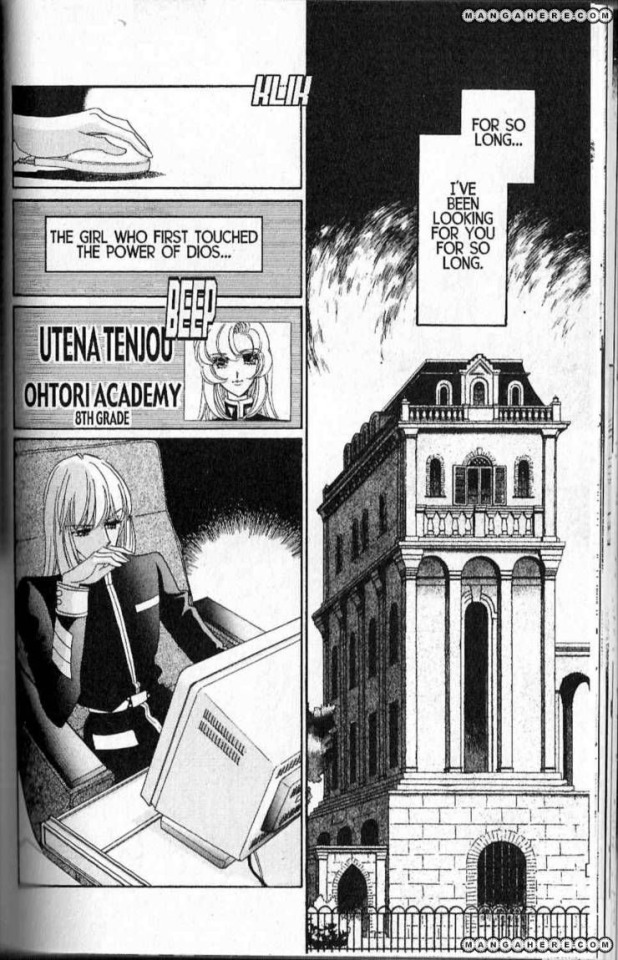
So here we are, the last chapter of the Utena Manga. The story finished in chapter 25, so this is another retcon side story slotting in an element from the show that didn't make it into the manga's main arc. This time it's Souji Mikage and Mamiya Chida of the Black Rose Arc. There was... a lot going on with that arc. All the character arcs of the various black rose duelists, the way they interacted with and advanced the arcs of the student council members, the kind of oblique, still not fully revealing anything hints at the greater machinations of the plot & Akio's hand on things, the idea that there's /way/ more going on with Anthy than even the first arc let on, and of course Souji & Mamiya's own characters and interactions - this last being the only bit that a single manga chapter's likely to be able to touch on, and even that I'm a bit skeptical of.
Because what's going on with Souji and Mamiya is kind of very gay, in a way that I'm just not confident will make the translation. I could talk more about Souji's repressed homosexuality thinly masked by compulsory heterosexuality posing as Pure Logic (tm), but I'd just be echoing C-Puff's excellent post that you can read for yourself (link).
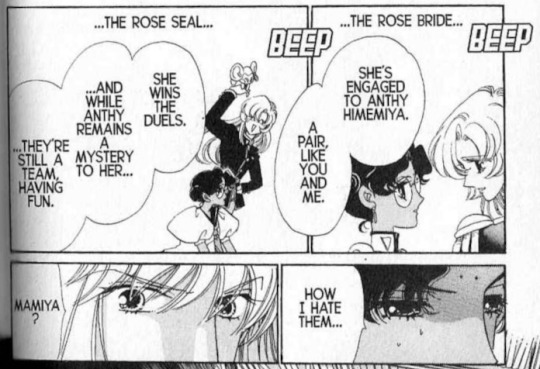
Will this Mamiya also turn out to be Anthy in the end? In which case, this statement that they hate Utena and Anthy stands out. Sure it could just be read as manipulating Souji, but otherwise, I mean sure hating herself for letting Akio control and manipulate her, sure, but also maybe resenting Utena who does so much to protect her while being seemingly oblivious to what she actually needs help from? Or forcing her to confront the experience of friendship that she doesn't think she deserves, or making her face the idea of hope when she had been sheltered from having to care by the hopelessness of her situation?
Anyway, Souji kicks things off by inviting Utena to a Lecture at the Nemuro Memorial Hall, location of anime's dark therapy elevator that makes you worse. Utena talks to Miki about it, and Miki confirms that the basic backstory here is the same as in the anime.
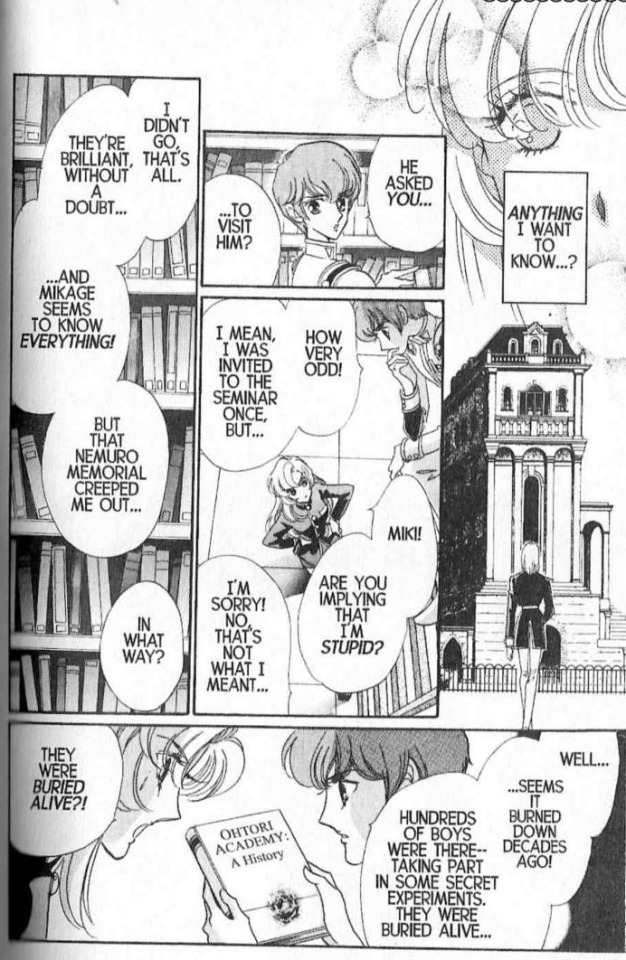
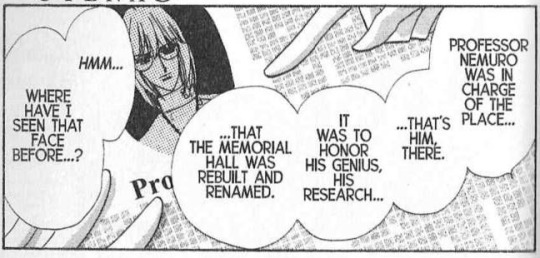
Come on Utena, I know you're dense sometimes, but that's clearly Souji, you just talked to him earlier today. I know it's weird that he's still alive and on campus decades after he died in that fire, but you've seen at least 3 weirder things than that by this point.
And you Miki! You have even less excuse.
Anyway, Anthy goes missing around the same time, and Utena follows a Convenient Hunch (tm) to look for her in the Memorial building, where Souji is waiting for her.
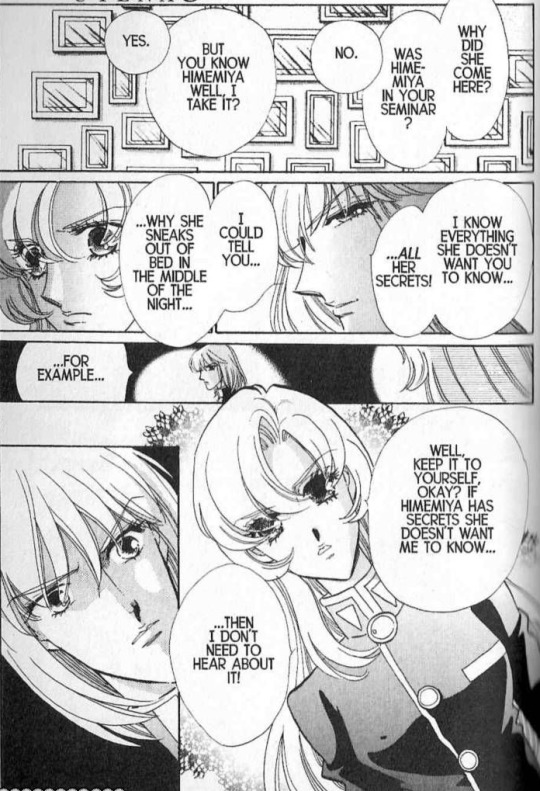
Good on you, Utena.
But if Utena's not vulnerable to mental manipulations, bad therapies, or forbidden secrets then that doesn't leave much for Souji to apply his signature computer-like brain to, so we just kind of skip straight to the dueling part. No, not in the arena, right here in the Memorial Building. Anthy's already there and dressed for the occasion, presumably because Mamiya is Anthy like in the show.
But this isn't any old Rose Duel.
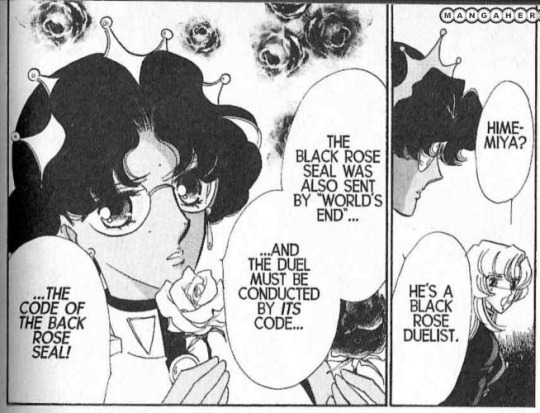
Was it ever spelled out in so many words that the difference between regular rose seal duels and black rose seal duels was that the black duelists were there to kill Anthy rather than possess her? Like that was clearly Mikage's goal, but still. Although... in the manga it was eventually revealed that the point of even the regular duels was for Anthy to die and the winner to replace her as Rose Bride themselves, so there's not really much of a difference here after all?

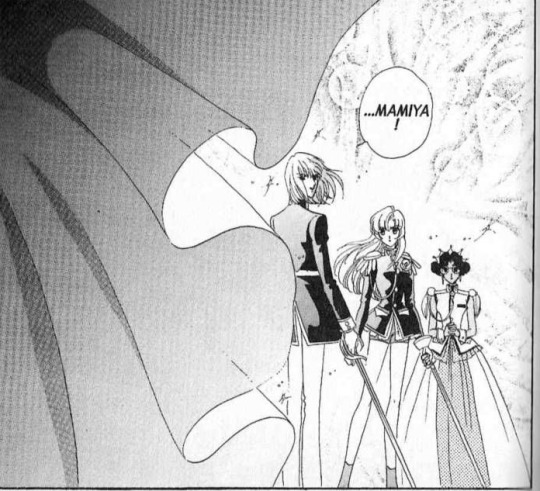
I like how this panel has like a drape that could be Mamiya standing in his own Rose Bride dress, but it's also pretty clear that Utena and Anthy don't see him there.
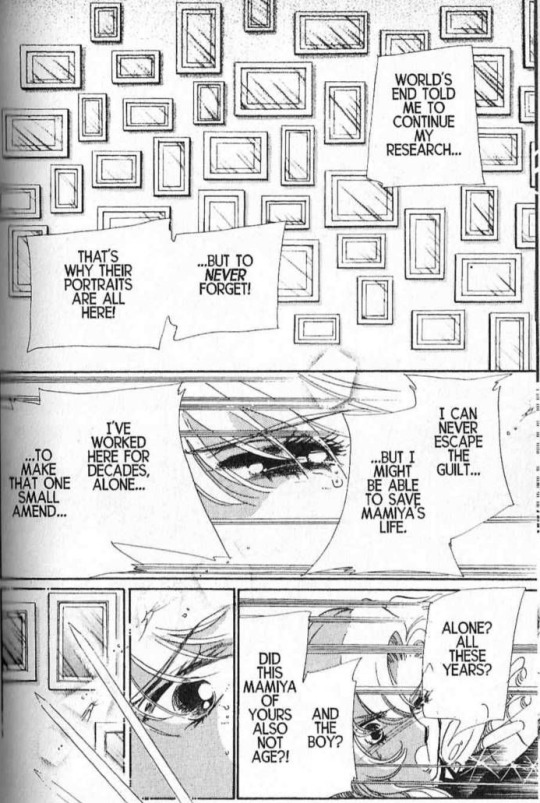
Unfortunately Manga Souji/Nemuro doesn't really have time to really establish the more complex relationship between him and Mamiya, so instead Manga Nemuro's core motivation is more about guilt for the students killed in the fire, and Mamiya is just one of those students - one he thinks he can save/revive if he defeats Utena and claims the power of Dios.
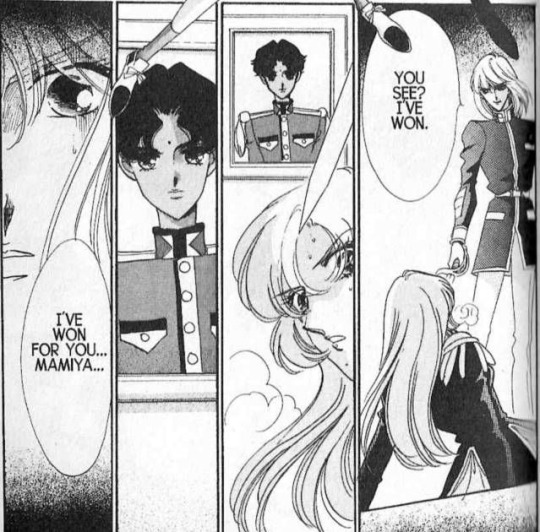
Manga Mamiya even always looked similar to Anthy, Souji isn't remembering him wrong, and Anthy isn't magically posing in his place after all. Which makes all the wondering about what Mamiya meant when he said he hated Utena and Anthy kind of wasted space, since it was just Nemuro projecting.
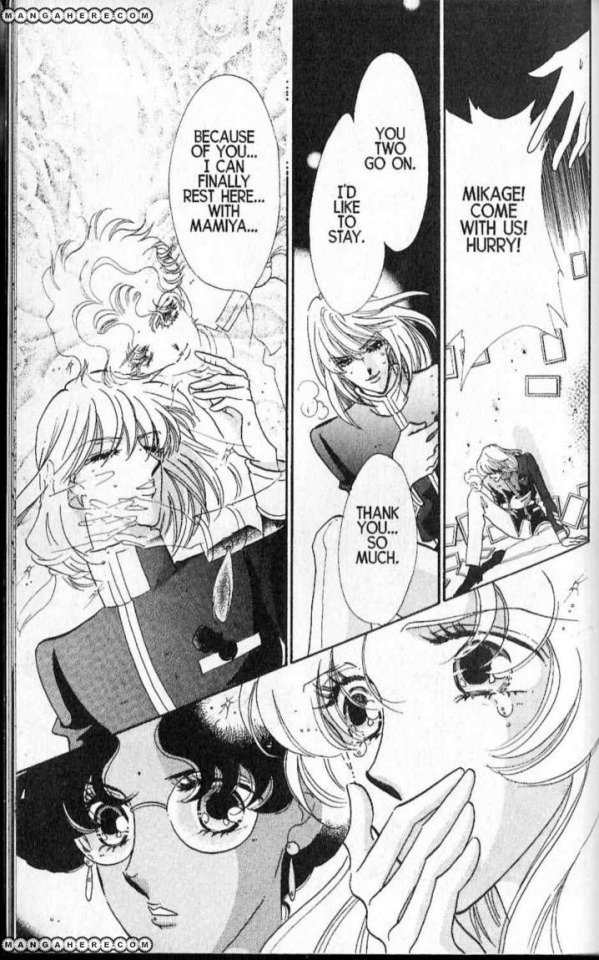
So anyway Utena wins the duel and the Memorial Building starts to collapse, and Mikage decides to stay behind with his memory of Mamiya while Utena and Anthy escape.

The manga version works in sort of a special Halloween Episode spooky ghost story sort of way, but it didn't really have the time to get into all the things that made the anime versions of Mikage and Mamiya so compelling, let alone the wider impact of the Black Rose arc as a whole. I enjoyed the chapter, but I'm left feeling more or less the same as I did about the bonus Ruka chapter - it was nice to see a manga version of these characters from the anime, but without the time or the framwork to fully dig into them it was probably a good call to leave them as side stories outside of the manga's more contained main plot.
26 notes
·
View notes
Text

The Geometric Part?
These should really have gone over to Outrageous, but these stand out stand up cuts were too good to hand over - for now at least. Mathematical and measured with protractors, or maybe spirit levels, the construction of the less austere Hard Part Pomp met by Ivy League Fuckboi is a rare breath of fresh air (naff expression, but it rhymes, so, you know…..)
Smart, striking and softer in style than its more shaven cousin. But - and this might just be me - there’s something obliquely kinky to these cuts.
If you’re thinking right now that I’m overselling this equated, elevated combover, the hair is about to get higher and the angles more erect. Even so, more of these please boys in whatever and various degrees, because the sum of these equations is a definite plus.
22 notes
·
View notes
Text
AB CRUNCHES
WHAT ARE CRUNCHES?
Ab crunches, which are sometimes mistaken for sit-ups, require the practitioner to raise their shoulders and upper back off the ground, which strengthens the rectus abdominis. With ab crunches, the lower back remains fixed to the floor, in contrast to sit-ups where the entire torso is elevated. This implies that it works fewer muscles than a sit-up, but it's still a useful exercise and can be beneficial for novices who find it difficult to stabilize their lower back during a sit-up.
Because they isolate the abs, ab crunches are a popular exercise for anyone looking to get a six pack. You can utilize the ab crunch machine or advance to dumbbell or cable crunches if you want to make this exercise more difficult. To work on your obliques, you can also do side crunches.
DO CRUNCHES GIVE YOU ABS?
Everyone possesses abdominal muscles, or abs, but whether or not these muscles are visible depends primarily on the amount of fat that covers them. Crunches can help define and strengthen the abs to provide the appearance of a six pack, but for many people, losing weight must also come first in order to show off the abs.
HOW MANY CALORIES DO AB CRUNCHES BURN?
Because there is little activity involved, performing ab crunches won't burn many calories. Resistance training, such as ab crunches, is best viewed as a way to build muscle rather than burn fat!
WHY DO MY ABS CRAMP WHEN DOING CRUNCHES?
When doing crunches, you should feel some stress in your abs; however, if you are in discomfort or feeling cramps, this could indicate that you are injured, overtrained, or just not strong enough. If you feel a cramp coming on, stop what you're doing and give your body time to heal.
WHAT DO SIDE CRUNCHES WORK?
One version of an ab crunch is the side crunch, which is crushing the torso to the side. Side crunches also target the rectus abdominis and the obliques.
DO SIDE CRUNCHES WIDEN THE WAIST?
It is theoretically possible for side crunches to increase waist circumference by strengthening the oblique muscles, which are the side waist core muscles. But that's not something to worry about because it would require a lot of training and an excess of calories to increase muscle mass to a noteworthy degree.
DO SIDE CRUNCHES GIVE YOU CURVES?
Side crunches are not likely to give you curves, but they also aren't likely to make your waist wider. Although side crunches can aid in defining the core, training the upper and lower bodies to develop a wider back with the intention of emphasizing curves is a superior way to get the popularly wanted "hourglass" appearance.
#Fitness#Health#gym#Workout#Exercise#FitnessGoals#GymLife#FitLife#Cardio#StrengthTraining#Yoga#Pilates#Running#FitFam#HealthyLiving#FitnessJourney#FitnessMotivation#Fitspo#Fitspiration#HealthyLifestyle#Sweat#TrainHard#NoPainNoGain#FitnessAddict#FitGirl#FitGuys#nutrition
2 notes
·
View notes
Text
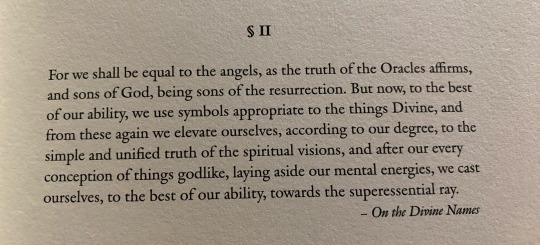
Currently (finally) reading Holy Heretics, and this quote in particular, as well as quite a few statements before this point, have really highlighted for me the pursuit of Chumbley & Co. and led me towards finally organizing my thoughts on certain aspects of their final products that I've mostly kept to myself hitherto.
I've read quite a few books by the Cultus Sabbati group now, as well as plenty of others such as Paracelsus and Alm, and while I'm reading Acher's work, I find myself reflecting, even without intentionally doing so, on the chthonic Greek initiation rites I had put together. Perhaps due to the non-dualistic perspective on cosmology I have, after their first draft, I started unraveling those rites and leaving almost "placeholder slots" in them where I had previously affixed Greek-specific rivers, deities, and mythological references. Now, when I'm reading this book in particular, it becomes even more obvious 1) why I was so intent on unraveling my own views on those rites and my cosmology in general (and in turn, how useful that ended up being), and 2) how Chumbley's works, and a few of his peers, appeared to crumble in their pursuit of a homogenous, one-size-fits-all-or-does-it concept.
"But now, to the best of our ability, we use symbols appropriate to the things Divine, and from these again we elevate ourselves." This sentence in particular feels like a perfect summary of where/why the Cultus' books fell short for so many I've seen attempt "decoding" them.
In the pursuit of transcending and "encoding" their work, a lot of the symbols, names, and concepts they latched onto and blended lost their ability to be used effectively in their presented form. Often, my peers would relate back to me that DBoE rites, if worked through to the letter, took many more hours than anticipated and that time seemed to just fall away and be absorbed into the working, and then when they inevitably restructured and reworded them to their needs/desires, they had an increased impact, reliable results, and took a significantly less amount of time. Truthfully, Chumbley & Co.'s works are the outer emanations of an inner, closed group, so it can, and really imo should, be argued that those extra bits and bobs and the declared so-called "ciphered" way of writing is done intentionally and that these results may in fact be what they'd intended all along. There can be a multitude of reasonings attached, but my ending note is the same:
The symbols used, in any system, must be adequate to the practitioner's understanding and relation to the divine in order to be usable in the pursuit of transcendence and unity with that which is beyond.
Cultus works just so happen to be the first that come to mind for me, especially given how quickly I have seen folks discard them entirely. A mish-mosh, rushed undertaking of DBoE will likely leave you in a room surrounded by just thoughtforms and archetypes rather than with a powerful eminence of divinity. And while this was more than likely the intended affect, it is still worth reflecting on for those like me who seek out experience with multiple different paths and systems.
It is something I have seldom verbalized, but that I carry with me when developing or seeking the understanding and knowledge necessary to undertake new ways of thinking and organizing the world around me. And, quite honestly, I think it is better put in this way than in the multitude of articles and entries I have seen that cryptically and obliquely describe Chumbley's works as "ineffectual" or "overhyped."
It is a matter of perspective, at the end of the day. Perspective and perhaps willingness to embrace the essence, rather than the presented, Crooked Path around you.
#magic theory#cultus sabbati#frater acher#holy heretics#witchblr#witch community#occultblr#deity work#spirit work#occult books#occult studies#occult study
31 notes
·
View notes
Text

The 1946 Aleutian Islands earthquake occurred near the Aleutian Islands, Alaska on April 1, 1946. The shock measured (Mw) 8.6, Mt 9.3 or (Ms) 7.4. It had a maximum Mercalli intensity of VI (Strong).[3][4] It resulted in 165–173 casualties and over US $26 million in damage. The seafloor along the fault was elevated, triggering a Pacific-wide tsunami with multiple destructive waves at heights ranging from 45–138 ft (14–42 m). The tsunami obliterated the Scotch Cap Lighthouse on Unimak Island, Alaska among others, and killed all five lighthouse keepers. Despite the destruction to the Aleutian Island Unimak, the tsunami had almost an imperceptible effect on the Alaskan mainland.[5]
Tectonic setting
Map showing the tectonics and seismicity of Alaska
The Aleutian Islands are a group of 14 large and 55 smaller volcanic islands situated between mainland Alaska and Kamchatka.[6] They are situated along the Aleutian Trench as they were formed by the active subduction of the oceanic Pacific plate underneath the continental crust of the North American plate.[7] The western portion of the trench becomes more and more oblique until near the Commander Islands where faulting becomes nearly exclusively strike-slip and causes earthquakes such as the 2017 Komandorski Islands earthquake.[8] The trench ends where the Kuril-Kamchatka Trench begins in the west.[8] In the east, the trench extends for a couple thousand miles before reaching the transition zone near Yakataga responsible for creating earthquakes such as the 1899 Yakutat Bay earthquakes.[9] The collision totally ends slightly further east, where the Queen Charlotte Fault becomes the dominant fault of the tectonic regime.[9] This specific area of the Aleutian Islands is thought to have ruptured in the 1585 Aleutian Islands earthquake.[10]
#moid moment#moids#ywnbaw#radfem#terfblr#terf#terfs please interact#radblr#radical feminists do touch#radical feminist#terfs please touch
2 notes
·
View notes
Text
Tim Clarke’s 2023: Ears on the Prize
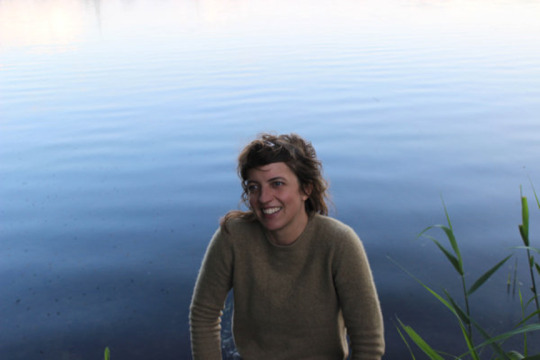
1. Rozi Plain — Prize (Memphis Industries)
youtube
Even though it was released way back in January, Prize is such an understated album that it nearly slipped under my radar completely. It popped up on some mid-year lists, including that of Dusted’s Margaret Welsh. The initial hook for me is that Rozi Leyden plays bass in This is the Kit (see my #3), but I had no idea she wrote and released her own music. From initial listens I was utterly beguiled, the economy of the songwriting and the richly colorful arrangements drawing me into obsessive repeat listens. Prize is a supremely absorbing and gently uplifting album, and one that I’ve played and enjoyed more than any other this year. Its beauty and clarity gradually reveal subtle, intoxicating depths.
2. Jana Horn — The Window is the Dream (No Quarter)
If Prize dominated my listening in the second half of 2023, it was The Window is the Dream that took pride of place in the first half — and it was one of my picks in the Mid-Year Exchange. They’re similarly oblique and alluring albums, but Horn’s record is shot through with a shadowy disquiet that seems to evoke a love gone sour. The chemistry among Horn’s band, especially the standout turn from electric guitarist Jonathan Horne, is truly something to behold, and elevates this superficially simple album into another realm entirely.
3. This is the Kit — Careful of Your Keepers (Rough Trade)
youtube
Rozi Leyden has played a key role in not one but two of my favorite albums of the year. The second is This is the Kit’s Careful of Your Keepers, notably produced by Super Furry Animals’ Gruff Rhys. Rhys shepherded the long-standing indie-folk band to create their best album to date, on which Kate Stables’ intimate songwriting is given a fresh, expansive dimension.
4. Wilco — Cousin (dBpm)
It was producer Cate Le Bon’s involvement in Wilco’s latest that piqued my interest, but thankfully Jeff Tweedy and co. have also brought their A-game on this one. Supposedly conceived pre-pandemic and then shelved, Cousin is a gloriously deep and emotionally engaging album from a band who have always seemed, to me, on the verge of creating something great, but never quite get over the line. With Le Bon’s help, Cousin takes a confident step beyond.
5. Pile — All Fiction (Exploding in Sound)
youtube
It’s taken for granted that Pile can dole out cathartic, noisy guitar records, but All Fiction feels different. Rick Maguire, Alex Molini and Kris Kuss maintain the electric dynamic they’ve always possessed, but shift their focus onto making the music between the crescendos more immersive and textural. It works brilliantly.
6. Meg Baird — Furling (Drag City)
youtube
Furling was released so early in the year, and so much great music has been released since, that it’s easy to forget just how good it is. As noted in my Dusted review, “Baird’s voice is an instrument of rare beauty, simultaneously assured and elusive, like a soft-focus Sandy Denny wandering in a fever dream.” When you situate such a voice within some of Baird’s best songs to date and embellish them with sensitive playing by her partner, Charlie Saufley, you’ve got a record of enduring beauty.
7. Devendra Banhart — Flying Wig (Mexican Summer)
youtube
Flying Wig is the second album on this list to be produced by Cate Le Bon. Here, Le Bon’s aesthetic is writ large, from the melancholy drift of the synth arrangements to the heavily modulated saxophone parts. Through it all Banhart sounds acutely lonely, while also luxuriating in the beauty of his musical backing. It’s a heady vibe, that’s for sure.
8. King Krule — Space Heavy (XL)
youtube
There are few musicians who simultaneously come across as hopelessly spaced out and gutturally pissed off at the same time. Archy Marshall is one of them, and his latest album drifts even further into dislocation and bewilderment than 2020’s stellar Man Alive!
9. Arrowounds — In the Octopus Pond (Lost Tribe Sound)
No other album released this year has quite sounded like Arrowounds’ In the Octopus Pond. It’s a singular and immersive blend of ambient and post-rock that evokes exemplary reference points such as Bark Psychosis, Dif Juz, and The World On Higher Downs. And if you enjoy this, Ryan Chamberlain has released another three albums this year, each venturing in a different direction.
10. Cory Hanson — Western Cum (Drag City)
youtube
Wand’s Cory Hanson put out his excellent second album, Pale Horse Rider, in 2021. It features a little six-string extroversion here and there, but doesn’t quite prepare the listener for album number three. Western Cum is Hanson in full guitar-hero mode; his playing is absolutely blistering. Though nothing on the album quite surpasses early single “Housefly” for sheer wind-in-your-hair thrills, Western Cum is a supremely enjoyable rock record, built to be played loud.
Also excellent (in alphabetical order):
Activity — Spirit in the Room (Western Vinyl)
Daniel Bachman — When the Roses Come Again (Three Lobed)
BCMC — Foreign Smokes (Drag City)
Califone — Villagers (Jealous Butcher)
James Ellis Ford — The Hum (Warp)
PJ Harvey — I Inside the Old Year Dying (Partisan)
Tim Hecker — No Highs (Kranky)
Blake Mills — Jelly Road (New Deal / Verve Forecast)
The Necks — Travel (Northern Spy / Fish of Milk)
Andy Shauf — Norm (Anti-)
#dusted magazine#yearend 2023#tim clarke#rozi plain#jana horn#this is the kit#wilco#pile#meg baird#devendra banhart#king krule#arrowounds#cory hanson
5 notes
·
View notes